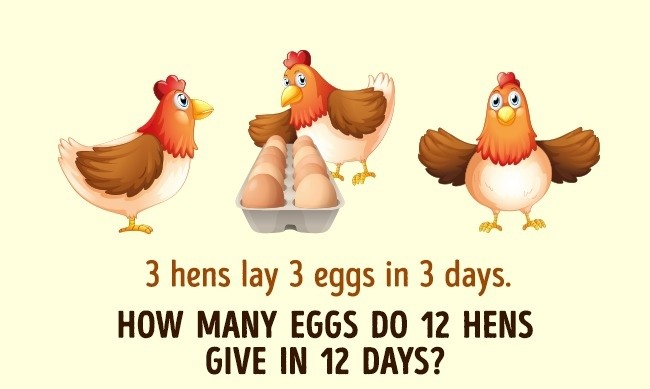Ready to test your brainpower? Let’s dive into one of those deceptively simple math riddles that trips up even the smartest minds. At first glance, it feels like a basic word problem, but don’t let it fool you. It’s more about pattern recognition and logic than arithmetic.
So here’s the riddle:
3 hens lay 3 eggs in 3 days. How many eggs do 12 hens lay in 12 days?

Seems easy, right? Most people rush to calculate and often land on the wrong number. Let’s break it down together — step by step — and see if you catch the trick behind it.
Step-by-Step Breakdown: How to Solve the Puzzle
Now, let’s solve this riddle together the right way. No shortcuts. Just logic.
Step 1: Understand the baseline rate
We’re told:
3 hens lay 3 eggs in 3 days.
So what does that mean?
Let’s simplify. That’s basically saying:
Each hen lays 1 egg in 3 days.
That’s our foundation. From here, everything scales.
Video : 3 Hens lay 3 Eggs in 3 Days. How many Eggs 12 Hens give in 12 Days Puzzle Answer
Step 2: Calculate how many eggs 1 hen lays in 12 days
If 1 hen lays 1 egg in 3 days, then in 12 days, it will lay:
12 ÷ 3 = 4 eggs.
So:
1 hen = 4 eggs in 12 days.
Step 3: Multiply by the number of hens
Now we have 12 hens. If each hen lays 4 eggs in 12 days, then:
12 hens × 4 eggs = 48 eggs.
Correct Answer: 48 eggs in 12 days.
Why This Puzzle Is More Than Just Math
You might be thinking, “Okay, so it’s just a ratio problem.” But there’s more to it than meets the eye. This riddle reveals how easily our brains can jump to assumptions.
Many people see 3 hens and 3 eggs in 3 days and assume the hens lay one egg a day. But that’s not accurate. In this puzzle, one hen lays an egg every three days, not every day.
It’s all about slowing down and re-reading the question with a clear focus.
Let’s Review with a Visual Example
Still unsure? Here’s a visual breakdown:
Day 1–3:
Each hen lays 1 egg = 3 eggs total (confirmed by the riddle)
Now stretch that pattern over 12 days:
Each hen lays 1 egg every 3 days → 4 eggs in 12 days
Multiply that by 12 hens = 48 eggs
There’s your final answer. It’s simple once you spot the logic, but tricky if you rush.
Video : Video 23│3 HENS Lay 3 Eggs in 3 Days. How Many Eggs Do 12 Hens in 12 Days?
Final Thoughts: Think Smarter, Not Faster
The next time you see a simple riddle, don’t rush.
Take your time, look at the structure, and think like a puzzle master.
So, to wrap it up:
3 hens lay 3 eggs in 3 days
1 hen = 1 egg every 3 days = 4 eggs in 12 days
12 hens = 12 × 4 = 48 eggs in 12 days
Answer: 48 eggs. Simple. Elegant. Logical.
Now it’s your turn!
Drop your answer in the comments and tell us how you solved it.
Did you get 48? Or did it trick you at first?
Tag someone who loves brain teasers and let them try it too!
And don’t stop here — try more riddles like this to boost your brainpower. Remember: it’s not about speed, it’s about strategy.




Leave a Reply